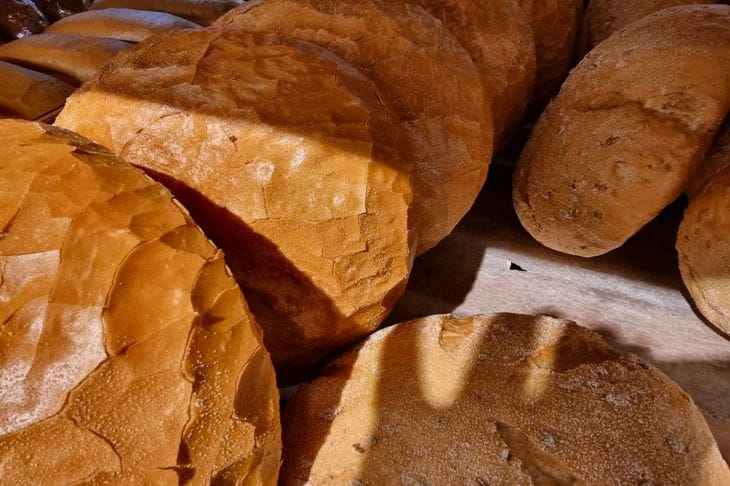Before you understand whether bread is harmful or healthy, you should study its composition.
The first thing worth mentioning is flour.
It is made from grains of cereals (wheat, barley, corn), ground to a powdery state. It is thanks to flour that bread has its structure.

Flour contains, firstly, starch, which is a carbohydrate and storage substance for plants.
Secondly, soluble (globulins, albumins) and insoluble proteins. When preparing this product, insoluble proteins form a network, which results in dough. This network is called gluten.
Another important element in making bread is liquid. This can be either water or some other liquid. For example, milk.
We must not forget about leavening. This is the process of adding a gas-forming substance to the dough. For example, yeast, which causes the carbohydrates in the flour to ferment.
In most cases, bread makers use baker's yeast, as it produces a fast-cooking, high-quality product. Also, sourdough is necessary in the bread-making process.
Thanks to it, lactic acid bacteria appear in the bread, which feed on the by-products of yeast fermentation and, ultimately, produce lactic acid.
Most microbes cannot live in an acidic environment, so sourdough is, in a way, a protector of bread from microorganisms.
General information
Knowing the composition of bread, we can talk about its harm or benefit. The caloric content of bread depends on the recipe for its preparation. The highest indicators are found in white bread, which contains about 342 kcal.
Depending on the recipe, bread can be yeast-free (made from premium flour), white, which in turn is made from premium flour or coarse flour, or from whole grains.
Also bread is a loaf, which contains many additives, and rye bread (the most useful of all types of bread). Protein bread is also distinguished, in the production of which an increased amount of eggs and cottage cheese are added.
Benefits of bread
The most important thing in bread is carbohydrates. Starch and sugar are the main structure of the carbohydrate skeleton of bread. Thanks to them, our body receives glucose, which subsequently gives us energy.
The cereal from which bread is made contains many vitamins and minerals. We need vitamin A for normal metabolism and the formation of bones and teeth.
Vitamin B has a positive effect on the health of our nervous system and supports immunity. Bread also contains vitamin E, which is necessary to maintain normal hemoglobin levels in the blood.
If we talk about microelements in the composition of cereals from which bread is prepared, then these are, first of all, potassium and magnesium.
Bread contains fiber. It helps cleanse our intestines of toxic substances. Whole grain bread is especially useful in this regard.
What we should not forget about is plant proteins. The benefit of this protein for our body is to maintain healthy bowel function. It, like fiber, is involved in the process of removing toxins from the body.
Also, one of the important components of bread is Omega 6. This is a fatty acid that provides healthy skin and reduces cholesterol levels, which is especially necessary for older people.
Harm of bread
If bread contains so many important things, is it really impossible to do without it? As the physician and philosopher of the past Paracelsus said: "Everything is medicine, and everything is poison - it's all about the dose." So bread has its dose and its shortcomings.
Firstly, bread contains a lot of sugar. Because of this, it has a high glycemic index. Bread should be excluded from the diet of people suffering from diabetes and those who want to lose weight.
Secondly, sodium, which is also part of bread like other minerals. In certain quantities, this chemical element is necessary for our body to maintain water-salt balance.
Sodium has the insidious property of retaining fluid in our body, so eating a lot of bread at once is not a good idea. This rule especially applies to people with cardiovascular diseases.
Thirdly, almost all the fatty acids that were originally part of the cereals before the bread was made, end up in a complete form. That is, the preparation of bread reduces the beneficial properties of fatty acids to zero.
And finally, the protein found in bread does not contain enough amino acids that our body needs.
Types of bread
Unleavened bread is the healthiest of all types. Because it is not made with yeast, the process of making it becomes more complicated.
This bread has very little protein and a lot of fat, but its advantage is the absence of unnecessary additives that increase caloric content. Therefore, this bread can be recommended to obese people and athletes.
White bread is the most common. Its advantages are high content of carbohydrates, which we need in everyday life; high content of fiber.
Also, the main feature of white bread is starch, into which it breaks down during digestion. It is starch that can supply our body with energy for a long time.
In addition to the pros, there are also cons. White bread, firstly, has the highest glycemic index.
Secondly, the yeast used in production has the property of removing calcium from the body. And thirdly, for the preparation of white bread, premium flour is often used, which is devoid of useful elements.
If we talk about low calorie content, then rye bread wins in this issue. It is recommended by doctors to people suffering from obesity. It has a high content of vegetable protein and fiber and a low glycemic index.
If you are into sports, then protein bread will suit you. Such important aspects as low calorie content, low sodium content and, on the contrary, high calcium content, the presence of Omega 3, extremely low glycemic index make this bread indispensable for sports enthusiasts.
General recommendations
There are no clear limits for bread consumption for a healthy person, although there are some recommendations. Bread calories should not exceed 40% of carbohydrates consumed per day. Also, you should not eat more than 150 grams of bread at a time.
Giving up bread is also not a good idea. Giving up bread can cause a lot of problems.
Firstly, fatigue. Carbohydrates, depending on the recipe, bread is our energy, and their absence will lead to negative consequences (malaise, decreased cognitive abilities and performance). Secondly, a constant feeling of hunger.
If the body does not have enough glucose, we will constantly want to eat. Therefore, it is better to eat an extra bun on an empty stomach than not to eat at all.
Thirdly, lack of fiber can cause problems with the digestive tract. It's simple - there is no fiber, therefore, fewer toxins leave the body, which leads to putrefactive processes in the intestines.
Giving up bread can also lead to depression due to low glucose levels and hormonal imbalance.
Bread is an integral part of our diet. It has its advantages and disadvantages. It cannot be said that it is 100% harmful or useful. If you know your individual characteristics and dosage, then there will be no problems with the use of this bakery product.








